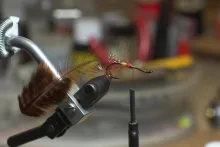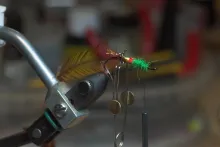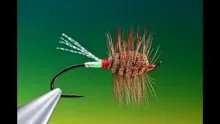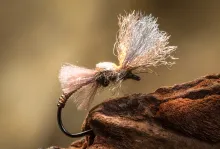The Green Machine is a classic salmon fly from the Eastern part of Canada. It's fished as a wet fly in spite of being tied with deer hair and a hackle like a bomber. This article shows you step by step how to tie it and shows an alternative and easier way to create the green body.
The Green Machine is a renowned fly in Northern America and Canada. This fly was originally tied as a bomber - a large hackled deer hair fly, tied to be fished dry for steelhead, skating over the water and stimulating some fierce attacks from these scaly silver bullets. The green bomber with brown tufts of hair front and aft was tied on the Miramichi river in New Brunswick for Atlantic salmon.
This version is tied to fish wet. Tied in the low water style with a small body on a large hook, it will dive under the surface in spite of its deer hair body and fairly large and dense hackle. This type of fishing also origins from the Miramichi and is sometimes referred to as "wet bug" fishing. The fly will oftentimes fish right under the surface or even in the film, but by using sinking line or leader, you can bring it further down.
Some tyers opt for a small gold tag rather than the tail, which we have tied here. The tag is less visible, and might be a good option for more spooky fish.
The deer hair body makes the fly somewhat a chore to tie, and we supply an alternative here: a simple, dubbed body. Since the fly is fished wet, the deer hair will have little impact on its flotation, and you can easily exchange the time consuming deer hair body with a quick and dirty dubbed one. If you want flotation, consider using a dry fly dubbing.
The flies in the pictures are tied by Ken Bonde Larsen.
|
|
|
|
|
|
|
|
|
|
|
|
|
|
|
|
|
|
|
|
|
|
|
|
|
|
|
|
Dubbed body version
Consider using dubbing for the body in stead of deer hair. The difference is difficult to see, and as long as the fly is fished wet, there is no reason to spin and trim deer hair to form the compact body.
- Log in to post comments







































Its a wonderfull fly
Its a wonderfull fly,i've caught many fish since i live next the the restigouche river and also fish the miramichi,my best one i tie with and orange hackle and rarelly go over a number 6 hook,thanks for sharing i enjoy this place for reading and getting new fly paterns.
The addition of the
The addition of the hackle as described by Jerome Malloy allows the tying thread to reinforce the hackle as well as the body hair, making this fly very durable. The tying thread sinks into the deer hair body and vanishes.when wound under tension. Tying the hackle on after you trim the body means that you didn't cut it off WHILE trimming the body hair, or maybe not.
Also, this fly has also been made with Phentex yarn ( a polypropylene yarn used to knit bedroom slippers) and UNI-Yarn.
This is one of the m
This is one of the most productive flies I use for brook trout here in central Newfoundland and I couldn't wait to try the dubbed version this spring. I've added a little glitter to the fly by adding a small amount of diced crystal flash to the dubbing and it has worked wonders.
This Web page has fa
This Web page has fantastic color images of fly patterns I have yet to discover. Can you tell me if the bomber style pattern or the green engine pattern can be purchased? Can it be purchased on from the internet? I found this page by acident, some perhaps I can get this fly somehow?
Thank you.
White goat or calf b
White goat or calf body are very good here in New Brunswick.Instead of tying the hackle in first at the rear I find it better to tie it by the butt at the front after the body is dressed and trimmed.Take one full turn at front and wind three turns to the rear.Chase the thread thru behind the hackle and return to the front.Whip finish and snap the hackle off by hand.Now your ready for the next and no waste.
Adding stacked white
Adding stacked white calf tail for the tail instead of the Crystal Flash works well also.
Nice pics, I tie and
Nice pics, I tie and use these alot. I also use a tight micro chenille for the body which makes for a streamline body..